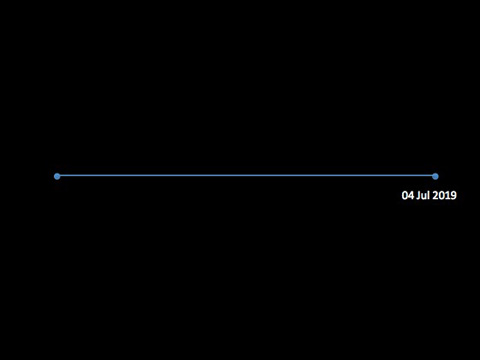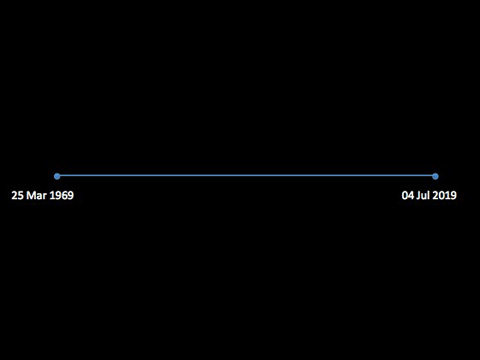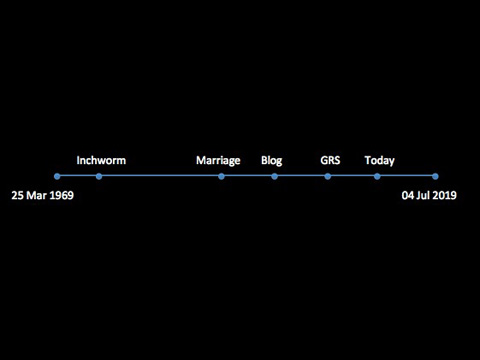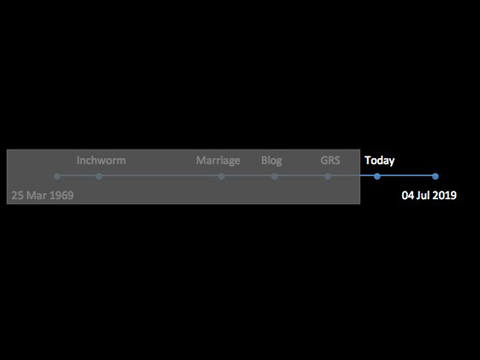Over the past couple of weeks, I’ve asked you to do some exercises to get at the heart of what brings meaning to your life. First, I asked you to find your big rocks in order to prioritize your time and life. Next, I had you answer George Kinder’s three questions to help figure out what you really want from life. Today, I’m going to share a third and final exercise (which I picked from Jim Collins last year in Ecuador).
Before we continue, please grab a piece of paper and a pencil. Ready? Great! Here’s how this works.
Step one. With the paper in “landscape mode” (wider than it is tall), place one dot on the center of the left side. Place a second dot on the center of the right side. Draw a line to connect the two dots. Your page should look something like this:

Place two dots on your paper and then draw a line to connect the dots.
Step two. For the next step, you’ll need to do some guesswork. Based on what you know of your health and your family history, estimate how long you’ll live. I know there’s no way to be sure — you could be hit by a truck tomorrow, or maybe next week scientists will find the secret to living 1000 years! — but do what you can to best guess the date of your death. (If you need help, try one of the many on-line longevity calculators, such as the one at livingto100.com.) Once you’ve calculated your projected date of death, write it below the right-most dot.

Note your projected date of death at the right side of the line.
Step three. Below the left-most date, note your date of birth. On your paper, you’ve created a visual representation of your lifeline.

Note your birth date at the left side of the line.
Step four. The next step requires a bit of math. You’re going to add a third point to your lifeline, a point that represents today. “Today” will fall on a different point on the line for each person. To find the proper place for you, divide your current age by your expected lifespan. For instance, I’m 45 and expect to live until I’m 50. For me, the point representing today is located about 10% from the right side of the line. If you’re 20 and expect to live until you’re 80, your “today” point would be about one-quarter of the way in from the left. And so on.

Place “today” at the appropriate place on your lifeline
Step five. Finally, choose a handful of major events from your life and place them on the lifeline in (approximately) the appropriate location. You might choose to list your first day of school, your wedding date, or the birthdates of your children. Add three to five major events to your lifeline.

Populate your lifeline with important events from your past.
Your lifeline is now complete. On the piece of paper before you, you have a representation of your life, both past and future. But before we’re finished, there’s one final step I’d like you to take. Using an eraser, a marker, or another piece of paper, mask everything on your lifeline that comes before today. Blot it out. Hide it. Make it go away.

Now cover up everything on your lifeline that occurred before today.
All of the time before today is past and does not matter. What matters is the future: today and everything after.
For folks like me, our projected futures contain just a small amount of time. Knowing that, I cannot wait to do the things that I want to do. If your projected future is short, you shouldn’t wait either. Don’t dwell on the past. You can’t change it. Focus instead on making the best quality tomorrow you possibly can.
On the other hand, if your projected future is long (say you’re 20 and expect to live another 60 or 80 years), cultivate patience. Take time. Make smart choices. Do what you can to set yourself up for future success. And don’t get down on yourself just because you’ve made a few mistakes in the past. The past is the past. Look how much tomorrow lies before you!

Sobering exercise, JD! I guess I’ve thought about the approx number of years I might “have left,” but there’s something about visualizing it like this.
Even for me, with an expected 31 years left, I don’t consider it a lot of time when compared to the big life events I still hope/expect to get in there before I go. Especially considering how quickly the first half of the timeline went by.
I was hoping to get my butt whipped into more action, because the whole post is quite inspiring in terms of “Today is the day”, but once I really drew things out, turns out that I am at 45 is merely past half-way point (women in my family live pretty long, and I am the healthiest in the bunch in terms of taking care of my health), and it was almost a bummer. You know, I was really eager to get a kick in the pants…No, but truly, thanks for making me think with many of your posts.
What a great exercise! I’m smack dab in the middle of how long I hope to / expect to be on the planet, but I spend a lot of time with my mom and her friends, who are all retired and about twice my age. Talking to them about their lives, in their retrospect, reminds me that life is long and there are many seasons to our lives. Your exercise helps me see that prospectively. Thanks for the insight.
Hey JD…
I had no idea that exercise made such an impression! It certainly did on me when I was first introduced to it.
Cool to see it here.
In any event, you neglected to share with your readers that you made it better with the addition of step #5!
Excellent, powerful and thought-provoking. My time line just got posted on my refrigerator. Thanks for the food for thought. It’s so important to really consider how I’m prioritizing my most valuable resource.
Thanks, I am glad to say that the ‘majors’ marriage, children, relative happiness are on there….day to day living with peace and compassion in all actions is the big one that is worth striving for.
PS I hope you live a long and healthy life…..like adding a few decades to 50!
I appreciate the work you do and the thought (and action) provoking posts.
Regards,
May I suggest Step 6- think about what milestones you want to achieve over the coming years and plot them on the timeline.
Then visualize the actions to be taken today, so as to achieve these milestones.